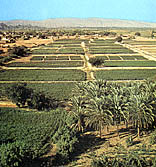
Land Reforms in the Former PDRY [Archives:1999/02/Business & Economy]
January 11 1999
Independence, when it came in 1967, brought an entirely different situation to South Yemen. The constitution asserted state ownership over all land, and a process of nationalization was implemented from 1969 onwards. This measures taken then still have a direct and immediate relevance to the contemporary situation in Yemen.

In particular, most land owners in Yemen were not feudal or pseudo feudal landowners. Most of the few who were, had fled at independence as they had been either supporters of the British or of the defeated Liberation movement – the FLOSY – as was the case of the Abdali in Lahej or the Qu’ayti and Kathiri ruling families in Hadhramaut, or large owners such as the Al-Kaf and others. Much of this land was turned into state farms.
Its repossession today has not created a group of dispossessed farmers, but rather a group of unemployed salaried and casual workers. In most areas, agricultural land had been held in small plots by farmers of tribal and other origins. However the revolutionary zeal of the NLF militants who lacked political sophistication and training meant that they insisted on implementing the Land Reform through intifadhat even in areas where there was no social basis to do so. As a result in many areas, farmers exchanged plots of land, handing to their colleagues their own pots and taking in exchange others of similar size and conditions. This process usually took place without bitterness and by mutual agreement, thus ensuring formal implementation of Land Reform while making little difference to local socio-economic conditions. In these areas there was almost no violence; if there was any it was unrelated to land redistribution.
In other areas, the situation was different and the intifadhat were an opportunity for settling scores, both through land redistribution and through the infliction of violence on former land owners and other ‘oppressors’ of the farming classes. This was the case in some parts of Wadi Hadhramaut, (particularly near Shibam and Seiyun), in Abyan Delta and Wadi Tuban.
The bitterness left by the Land Reform is still very much alive today. These events took place about 25 years ago and the people involved are still in many cases alive and present. Many of those who left the country during this period are now returning with thoughts of revenge. Once the lands were taken over, the farmers were encouraged to group into co-operatives. Initially it was intended that co-operatives would gradually progress towards common ownership and cultivation of the land, but this never materialized.
In practice, co-operatives were similar to co-operatives in other countries and functioned as institutions providing agricultural services (inputs, extensions) and organizing access to machinery through the Machinery Rental Stations. They were also representatives of the state as they collected taxes from the farmers and organized marketing through the centralized agencies for the various ‘strategic’ crops (wheat, cotton, etc.). They were also responsible for devising the cropping pattern within their area to fit into the national production plans, but this was difficult to implement effectively as farmers on the whole continued to cultivate the crops they favored.
By the 1980’s, there was no further talk of collectivization. Agriculture in the PDRY became increasingly privatized, with the co-operatives becoming mere providers of services and losing their controlling aspects, particularly with respect to cropping patterns. The State started to distribute long-term usufruct titles to farmers giving them full rights of inheritance etc. over their plots, and the co-operatives’ role was restricted to provision of extension inputs and collection of taxes. Newly reclaimed lands were all distributed with individual usufruct titles.
By the time of unification, the situation was in practice one of small holders with access to co-operative services.
By: Helen Lackner
——
[archive-e:02-v:1999-y:1999-d:1999-01-11-p:./1999/iss02/b&e.htm]


